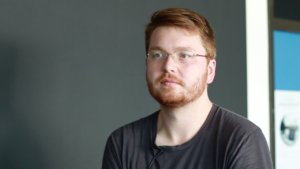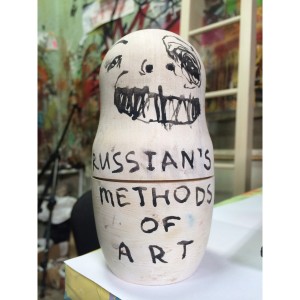Everything could be a work of art. It could be something physical, like this tree trunk or like Mocmoc that actually stands there as a sculpture. But a process can be art, too. And I personally am quite glad that there is a tendency of moving away from an object or a product in the contemporary art scene, and also away from a programmatic and in the direction of a process-based, situative approach. When I talk about Com&Com, we have at least two, if not more, work phases behind us. Our early works, that means the ones from about 15 years ago, were not object-like, but very programmatic. They were very strategic and strictly conceptual. They were deconstructing. We somehow tried to economize attention by means of strategies like branding, provocation, and irony and thus analyzed and deconstructed things. But in this way we also created distance. The concept always stood above everything and made us unassailable. Then there was a phase when we simply had enough of this deconstruction, of doubting, of doubting the doubting and the teasing and then not really getting involved with almost anything. And most of the time we knew what would come out in the end. It was a process that was played and that most of the time worked successfully. And then there was a phase when we reoriented ourselves. It was a long, also painful but exiting phase that went up to the point, when we considered splitting up or changing our name. And then we wrote this “Post-Ironic Manifesto” at the end of 2008, with which we created a programmatic basis for us to really sort of bring this change to paper. Or to simply create a guideline for ourselves. Right now project Bloch is running, it has actually been two years now. Bloch is based on an old folk custom from Appenzell, in which 20 men call the last chopped tree of the winter, a particularly beautiful and thick tree, Bloch. Bloch actually means the bottom part of the tree, so the most precious, thickest, branch less, best part of the tree. And that is Bloch. And they cut down a particularly pretty Bloch, the last one, in the winter. These 20 men then pull this tree, a spruce, from village A, Urnäsch to village B, Herisau and back again. On one day. On their way there are people that applaud. There is always some schnapps and the people get tipsy. There is music and it really is a celebration to the forest, a sort of Thanksgiving. It’s a tradition that dates back several hundreds of years ago. It’s a small tradition from the people in the woods, that is hardly known. I heard from it by coincidence and it made click. On the one hand because it had to do with our new artistic direction. On the other hand because it is simply such a strong image. We wanted to acquire this image and went there. We only filmed the parade and then started betting for the tree trunk against the locals. And they realized: there are strangers that are claiming our tree! The price went higher and higher, as high as never before. But we wanted that tree and ended up getting it for 3000 francs. But that was only the beginning of the project. Because our idea wasn’t to build a small bench with it or to make shingles. Or to pull it back and forth between two villages. We want to travel across the whole world with this tree. The idea is to be on every continent at least once or several times and to work with local artists on-site bases on their traditions and to work with them collaboratively. Bloch has become, to put it in Nicolas Bourriaud’s words, a part of the “post production”. So we offer something that’s already there and that becomes something new. There already is a cultural product of this tradition. But by buying it and putting a concept behind it, it became an artwork by Com&Com. And that gives the whole thing a frame, stage and nucleus – a crystal core – for new participation and collaborations that have a lot to do with inter- and trans cultural exchange and dialogue. Thus something, that has potential and creates the possibility for something new. We’ve been at different places so far. We’ve gone through St. Gallen, Bern, Berlin and Karlsruhe. There were different productions at all stations in Europe. There were concerts and performances in Bern. In Berlin there was a conference and a parade to Brandenburg Gate and more performances in Berlin-Kreuzberg. From there we went to Karlsruhe were we held a conference as well. Then we went to China. Everything was shipped there and became a part of the Shanghai Biennale 2013. We initiated projects with Chinese artists, which partly was a fashion show in which Bloch was used as a catwalk. There were concerts with traditional music, pop-music and there was a Chinese, a Beijing opera. Everything took place on top of, in front of and around Bloch. Like I said, it’s not too much about an object, about a classic work of art with the pure character of an object. It’s much rather about the process, about events and incidents that might disappear again. That’s why we film the whole thing, so we have at least a half-decent trace. A documentation that later, when we return to the art context and art market, can count as a work of art. Or at least can be shown as such.
Ein Werk kann eigentlich alles sein. Es kann eben etwas Physisches sein, wie dieser Baumstamm oder wie Mocmoc, das auch als Skulptur da steht. Aber es können eben dann auch Prozesse sein. Und ich persönlich bin eigentlich sehr froh, dass auch die Tendenz in der Zeitgenössischen Kunst wieder ein bisschen weg vom Objekt oder vom Produkt geht und auch weg vom Programmatischen hin zum Prozessartigen, Situativen. Wenn ich von Com&Com spreche, dann haben wir eigentlich mindestens zwei, wenn nicht mehrere Werkphasen hinter uns. Und unsere frühen Werke, das heißt, die vor fünfzehn Jahren oder so. Die waren, obwohl nicht objekthaft, waren die sehr programmatisch. Die sind sehr strategisch gewesen. Die sind streng konzeptionell gewesen. Die sind dekonstruierend gewesen. Also wir haben mit Strategien irgendwie (versucht) Aufmerksamkeit zu ökonomieren. Durch Branding, Provokation, und Ironie. Und dadurch Dinge analysiert und dekonstruiert. Aber dadurch auch immer eine Distanz geschaffen. Das Konzept stand immer drüber und wir waren unangreifbar. Und dann gab es eine Phase wo wir einfach genug hatten mit diesen Dekonstruktionen, mit diesem Zweifeln und dieses Zweifeln am Zweifeln und dieses Lustigmachen und sich nicht auf etwas wirklich einlassen. Und meistens wussten wir ja schon was hinten raus kam. Und das war ein Prozess, der durchgespielt wurde und meistens hat das auch erfolgreich geklappt. Und dann gab es die Phase, wo wir uns umorientiert haben. Es war eine lange, auch schmerzhafte aber spannende Phase, die hin ging bis zur Frage, ob wir uns auflösen, ob wir den Namen ändern. Und dann haben wir Ende 2008 dieses „Postironische Manifest“ geschrieben, wo wir uns so eine Art programmatische Grundlage schufen, um uns eigentlich selbst auch diesen Wandel und diesen Wechsel auf Papier zu bringen. Oder um einfach eine guideline für uns selber zu schaffen. Zur Zeit, seit zwei Jahren schon, läuft das Projekt Bloch. Bloch basiert auf einem alten Appenzeller Volksbrauch, bei dem zwanzig Männer, den letzten im Winter gefällten Baum, ein besonders schöner, dicker Baum, den sie Bloch nennen. Bloch meint eigentlich den untersten Teil eines Baumes. Dort, wo es keine Äste gibt, also eigentlich das wertvollste, dickste, astfreie, das beste Holz. Das ist das Bloch. Und ein besonders schönes Bloch, das letzte, schlagen sie im Winter. Und diese zwanzig Männer ziehen dann diesen Baum, eine Fichte, von Dorf A Urnäsch nach Dorf B Herisau und zurück. An einem Tag. Auf dem Weg stehen dann Leute, die applaudieren. Es gibt immer Schnaps, alle werden dann immer besoffener, es gibt Musik. Also es ist eigentlich auch eine Feier und ein Dank an den Wald, insofern Erntedank. Und das ist eine lange Tradition seit hunderten von Jahren. Und es ist so ein kleiner Berglerbrauch, den man eigentlich nicht so kennt. Und als ich dann von dem gehört habe, eigentlich per Zufall. Ja dann hat es Klick gemacht. Einerseits weil das mit unserer neuen künstlerischen Ausrichtung zu tun hat. Andererseits weil es einfach so ein starkes Bild ist. Und dieses Bild wollten wir uns eigentlich aneignen und sind dann dort hin. Wir haben eigentlich nur diesen Umzug gefilmt und haben begonnen mit zu bieten gegen die Einheimischen. Und die haben dann gemerkt: Hier sind auch Fremde dabei, die jetzt unseren Baum fordern. Und der Preis ging hoch und hoch. So hoch wie noch nie. Aber wir wollten diesen Baum und haben den dann bekommen für 3.000 Franken. Und das ist erst der Beginn dieses Projektes. Weil unsere Idee ist ja nicht, dass wir auch ein Bänklein machen oder ein Schindeln. Oder auch nicht nur zwischen zwei Dörfern hin und her ziehen, sondern wir wollen jetzt mit dem Baum einmal um die ganze Welt fahren. Also die Idee ist, dass wir in jedem Kontinent einmal sind und dort vor Ort mit lokalen Kunstschaffenden, basierend auf ihren Traditionen, mit ihnen kollaborativ tätig werden. Und da ist der Bloch eigentlich, um jetzt einen Begriff von Nicolas Bourriaud zu verwenden, einen Teil der „Postproduktion“. Also wir bieten etwas an, das es schon gibt und daraus wird jetzt etwas Neues. Also es ist ja schon längst ein Kulturprodukt von diesem Brauch. Dadurch, dass wir es gekauft haben und in ein Konzept reingelegt haben, ist es ein Kunstwerk von Com&Com geworden. Aber das gibt den Rahmen und die Bühne und das Set und den Nukleus – ein Kristallisationskern – eben für neue Partizipationen, Kollaborationen, der sehr viel mit inter- und transkulturellem Austausch und Dialogen zu tun hat. Eben etwas, das Potential hat und eine Möglichkeit schaffen für etwas Neues. Wir sind ja jetzt schon an verschiedenen Orten gewesen. Wir sind über St. Gallen, Bern nach Berlin, Karlsruhe gegangen. An allen Stationen in Europa gab es verschiedene Produktionen. In Bern gab es Konzerte und Performance. In Berlin gab es eine Konferenz und einen Umzug zum Brandenburger Tor und in Kreuzberg gab es auch Performances. Und von da ging es dann nach Karlsruhe. Da gab es auch eine Konferenz. Dann ging es nach China. Und das Ganze wurde verschifft. Und es war dann Teil der Shanghai Biennale 2013. Da haben wir chinesischen Kunstschaffenden Projekte initiiert. Das war einerseits eine Fashion- bzw. Modenschau. Der Bloch wurde als Catwalk benutzt. Es gab Konzerte mit traditioneller Volksmusik, mit Pop-Musik und es gab eine chinesische, eine Pekinger Oper. Alles auf und vor und um den Bloch herum. Es geht also nicht so sehr stark um ein Objekt, um ein klassisches Kunstwerk mit reinem Objektcharakter. Sondern es geht um Prozess, es geht um Events, es geht um Ereignisse, die auch verschwinden. Und deswegen filmen wir das Ganze, das wir wenigstens noch so halbwegs eine Spur haben. Eine Dokumentation, die dann später, wenn wir in den Kunstkontext und in den Kunstbetrieb zurück kehren, auch als Werk gilt. Oder einfach gezeigt werden kann.

















